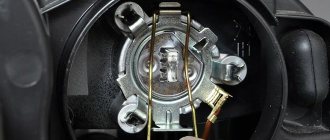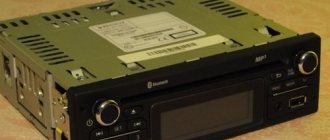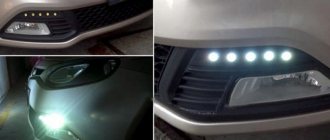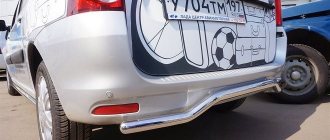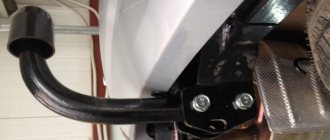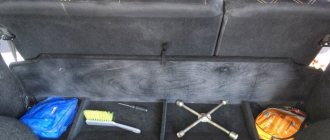A Lada Largus car that is sufficiently marked on the road surface is a guarantee of safety for both pedestrians and other drivers. In most countries, in order to indicate a car moving on the road, special lighting devices called daytime running lights have been regulated. Many car owners are interested in the question of how to install running lights themselves.
Daytime running lights for Lada Largus
- How can a car owner solve this issue?
- Installation options
- Equipment selection
- How to install lighting fixtures with your own hands
- We offer several installation options
- In conclusion about installing running lights
Seeing a car moving on the road in time is one of the main conditions for preserving the lives of pedestrians and motorists. Many countries around the world have included the light designation of a moving vehicle as mandatory in their road safety regulations.
Daytime running lights Lada Largus
Let's sum it up
PTFs are quite useful devices that help the driver move confidently in difficult weather conditions. As you can see, not all Lada Largus configurations initially have such lighting devices in their arsenal. For caring owners, this is not an obstacle, and they easily purchase and install PTF in their cars.
We examined two options for installing lighting equipment in LADA Largus and found that they are quite simple. If your station wagon does not yet have these useful products, then feel free to purchase them and install them, after which the bad weather will not be able to scare you.
Choosing DRLs for Lada Largus
In the case when the Lada Largus is not equipped with DRLs at the factory, they can be installed using two methods:
- Contact a specialized service station.
- Install with your calloused hands.
Lada Largus, which was equipped with DRLs
Your choice should be on reliable DRL models. Parts from China will cost less, but European lights will last longer . Here you need to choose depending on your wallet. Experts note that high-quality domestically produced lights are quite difficult to find.
Factory version according to GOST
The most reliable and most expensive! The original kit from dealers will cost at least 5,000 rubles.
It includes:
- Lamps for fog lamps (2 pieces).
Replacing standard trims with PTF with DRL
Original DRL control unit
Connection diagram
DRL connection diagram for Largus
Ordinary lamps from CHINA
Option for installing DRL lights in fog lamp covers
The cheapest and most unreliable option. But the cost of 250 rubles is very tempting.
The installation of such DRLs is as simple as possible - they are simple, the positive wire is thrown to the ignition (in the relay), the negative wire is connected to the ground of the car.
The easiest to install DRL option on Largus
Installing factory daytime running lights
If you have at least basic skills and knowledge of the car’s electrical system, then you can do the work of installing DRLs on your own. The work will take no more than an hour.
If the lights were purchased in a store, then installing them will not be difficult. The kit includes instructions for their installation, and therefore all actions should be performed according to the rules described there. If any difficulties arise in this, you should contact the service station.
Algorithm
- We install the DRL ignition unit under the hood.
We carefully attach the ignition unit under the hood
For reliability, check the voltage on the block in the relay when turning on the ignition
Homemade daytime lights
Those who do not want to spend money on purchasing factory DRLs can make them themselves, following these recommendations:
- You need to prepare the wires, LED strip and plugs for the headlights.
- The tape should be cut to the required sizes.
- Holes for the strips are drilled on the plug.
- The wires are soldered to the strips.
- The strips themselves are attached to the plugs.
- The wires are being connected in the engine compartment.
- The wires can be connected to the fuel pump relay. In this case, the lights will light up automatically when the ignition is turned on.
How to quickly replace PTF?
Fog lights on the VAZ-2109: installation and connection method
If the light fixtures we are considering are damaged, then replacing the fog lights will not take much time. Next, we will provide instructions using the example of the left PTF, since all manipulations with replacing the right headlight will be absolutely identical.
We use a Phillips screwdriver as a tool for work.
We operate from under the LADA Largus car quickly without dismantling the front bumper.
- First we remove the front fender liner (left).
- We press out the latch that holds the cable harness block.
- We remove the block itself from the base terminal of the headlight.
- Next, unscrew the three screws that hold the PTF in the bumper seat.
- We take the headlight out and put it aside.
- We install a new lighting device into the resulting niche.
- We connect the PTF to the network and check the functionality.
- We return the fender liner to its original place.
- If necessary, adjust the light beam.
How to choose equipment?
The owner of the Lada Largus model, as expected, strives to provide his car with the opportunity to stand out in traffic even on a sunny day. For this purpose, you will need sufficiently powerful running lights that can meet the following requirements:
- provide a luminous flux in the range of 400 - 800 Cd (this indicator can be achieved using two diffusers with dimensions of 100x20 mm;
- consume current with a force of 1 Ampere and above;
- have a metal case with efficient cooling.
For the Lada Largus model considered here, sets of running lights are manufactured by various manufacturers. The choice may be influenced by the cost of the products. Chinese analogues are cheaper, but cannot surprise you with their quality. European DRLs are much more reliable, but their price can be steep. Self-made options also have a right to exist, but are not always the best choice.
Installation options
So, if the Lada Largus is not equipped with this lighting system at the factory, then to resolve the issue of installing it, you can go in two ways:
- Contact a service station, where you will be offered a full range of services - from purchase to installation.
- Install them yourself. In this case, there are also two options: installing a kit purchased in a store or making it yourself. The homemade version will be discussed below. To be able to carry it out, it is necessary that the government regulations in force in the territory of your residence do not contain a ban on making such changes to the Lada Largus car.
If the Lada Largus is equipped with this system at the factory, then try it in motion. Most likely, you will want to replace this lighting equipment with a more efficient one.
Daytime running lights for Lada Largus LED
How to replace a PTF lamp on a Lada Largus
It is necessary to unscrew 3 screws and pull out one clip securing the lower apron
Next, without removing the large piston, carefully turn the apron to the side
Now we can easily reach the lamp. Turn it half a turn counterclockwise, remove it and install a new one.
Here you also need to unscrew 3 screws and pull out 2 clips
Pull out the large piston, carefully move the shield to the side and replace the lamp
Reassemble everything in reverse order. Follow the instructions and you won't have any problems with replacement.
To adjust the PTF on Largus, a special screw was provided. Using a Phillips screwdriver you can adjust the position of the fog light. The adjustment hole is located on the PTF mask.
How to install DRL yourself?
If the owner has a minimum amount of knowledge in the field of automotive electrical equipment and the necessary tools, then solving the problem in this case will not take more than two hours of time. To avoid poor quality work, before selecting products and starting installation, we recommend that you familiarize yourself with the basic requirements in detail. Errors that may manifest themselves during the installation of DRLs can cause significant complications, both during road traffic and during the investigation into the causes of an accident (if it occurs).
Installed running lights must be equipped with the following functions:
- the ability to turn on and off when starting and stopping the engine, respectively;
- ability to activate without the use of additional tools;
- automatic deactivation when the head optics are turned on, leaving the possibility of short-term activation to provide a signal on the road;
- compliance with the required geometry after direct installation:
- the distance between these light sources should not exceed 600 mm;
- the same dimensions to the extreme point of the body (width) - no more than 400 mm;
- in height to the road surface, the minimum parameter should be 250 mm, and its maximum value should be 1500 mm.
Having familiarized yourself with these regulatory requirements, you can safely begin installing DRLs on your Lada Largus car yourself.
How to install lighting fixtures with your own hands
With basic knowledge of the Lada Largus electrical system and skills in using plumbing tools, you will solve this issue in no more than an hour.
But before you buy components for Lada Largus and begin installation, study the basic requirements so that the work is not in vain. Mistakes when doing it yourself can lead to complications both while driving and during the investigation after a possible accident.
Mounted daytime running lights of the Lada Largus must provide:
- automatic switching on and off. When the engine starts, the lights turn on, and when the engine turns off, they turn off;
- the ability to turn this function off and on without any additional tool;
- automatic extinguishing when the main light is turned on, except for cases of short-term use of it to provide a light signal to other traffic participants;
- the necessary geometry for installing light sources: between them - at least 600 mm, from the extreme point of the body side - no more than 400 mm, from the road surface - at least 250 mm, maximum - 1500 mm.
Now that you know the basic requirements for the results of the work, you can get started.
We are starting to install running lights on the Lada Largus.
General requirements for DRL
DRL scheme according to GOST
These elements have special requirements that must comply with GOST, namely:
- The lights should turn on automatically.
- It should be possible to force the lights to turn off.
- DRLs should turn off automatically when you turn on the lights in the car.
- Emitters must have an area of no more than 40 centimeters.
- The light power should not be more than 800cd.
- The light should be white.
- There should be no more than 2 headlights.
Making changes to the car design
When installing running lights yourself, you should also remember that their installation will be considered as making changes to the design of the car. If the car does not have DRLs, then during the daytime you can turn on the low beams or fog lights.
But it is recommended to use daytime lights, since this option is the most rational. If you turn on the lights or fog lights, this will lead to wear and tear on various elements of the car, for example, side lights or instrument panel lights. When switched on, DRLs do not require additional fuel consumption. They can work autonomously and save gasoline.
Option one is to make running lights for the Lada Largus car yourself. This can be done as follows:
- an LED strip is used as a light emitter (diodes 5050, 12 V, 14, 4 W), two wires of different colors, a plug for the headlights;
- for placement on the plug, 2 strips 25 cm long and 6 strips 10 cm long are cut;
- holes for wires are drilled in the plugs to suit the size of the strips;
- solder the wires to the edges of the strips. They are placed on plugs, secured with silicone and additionally with brackets. The wires are routed to the reverse side;
- To better preserve the light emitters and reduce the flow of light, you can use a polyvinyl chloride tube. In this case, the light source must be placed in it;
- basic wire communications are carried out, then the entire assembled circuit is connected to the Lada Largus fuel pump relay. Thus, the running lights turn on when the engine is started and turn off when the engine is turned off. In the future, they can be connected differently - through an additional relay, so that when the side lights are turned on, they go out.
Manufacturing and installation of equipment has been completed. Quite simple and inexpensive. Of course, this is not an ideal option, and it will not suit everyone. Give it a try.
Option two - original running lights for Lada Largus cars:
- These are LED lamps available to any car owner. Here you will also do without a service station. Replacing factory lamps is a breeze;
- make no mistake when purchasing them, the light emitted should be of the same shade. This requirement is mandatory.
Option three is to install a store-bought kit.
Here, at first glance, there is a minimum of difficulties. There are instructions - study and act! But don't rush to start. Soberly evaluate your knowledge of the electrical equipment of the Lada Largus car. Try to follow the instructions on how to install and connect the purchased kit. If you are confident in your own abilities, proceed. If not, it is better to contact specialists at a service station. Practice shows that without special technical training on the Lada Largus electrical system, installation of such equipment, even according to the instructions, is quite complicated.
How can a car owner solve this issue?
"Lada Largus" allows you to do this using:
- dipped headlights;
- fog lights;
- daytime running lights (if they are installed on the car).
From this list, we recommend the last option for regular use, as the most rational. The remaining examples are inferior to this solution. When using them, the dashboard lighting elements and side lights come into play additionally and unnecessarily wear out. When switched on, they require additional fuel consumption . Running lights, working independently from other lighting devices, will save fuel. Yes, the reduction in consumption is small, but it is also your money.
Running lights for Lada Largus.
Installation Requirements
The “Technical Regulations on the Safety of Wheeled Vehicles” stipulate not only the conditions that DRLs installed on a vehicle must comply with, but also the requirements for the conditions of their installation. At the same time, the installation standards for DRLs adopted in the European Union and Russia are somewhat different from each other.
According to traffic regulations, daytime running lights must be installed on:
- public transport (taxi, minibus, etc.);
- motor transport;
- vehicles transporting oversized or explosively dangerous cargo;
- vehicles used to transport minor children.
DRLs are installed correctly if:
- the distance from the ground is within 0.25. 1.5 m;
- the distance between them is at least 60 cm. This distance can be reduced to 40 cm if the width of the car body does not exceed 1300 cm;
- the distance from the edge of the body to the installation site should not exceed 400 mm.
The requirements for connecting DRLs to the vehicle’s on-board network are set out in GOST R41.48-2004 and provide that:
- the lights should automatically turn on when the ignition is turned on and turn off when the headlights are turned on;
- The area of the emitters should not exceed 40 square meters. cm;
- the luminous flux power should not exceed 800 cd;
- quantity - 2 pcs.
The same standard shows the DRL connection diagram:
Examples of installing DRLs on a LADA Largus car are shown in the photo:
Do-it-yourself Largus Cross tuning
Modernization of the model is mostly aimed at increasing the level of comfort, reducing fuel consumption, increasing dynamics, and improving appearance.
Engine
One of the options for tuning the car in question is to improve the power unit, which is capable of developing from 102 to 106 hp. depending on the settings and features of the motor. For a measured ride, these characteristics are quite enough. However, there are car enthusiasts for whom the standard power is not enough. You can modify the engine in the following ways:
- perform chip tuning by flashing the electronic control unit;
- change characteristics by replacing engine parts.
Selection of PTF by color and markings
Fog lamp glasses must be milky or yellow. This way, optical rays are scattered much better in poor visibility conditions. Transparent headlights cannot be called fog lights, like blue or red products. For colors not in accordance with GOST, you can get a fine from the traffic police, since installing such fog lights in the front is prohibited.
There are certain nuances when choosing lamps depending on the color of the filter. If the PTFs are yellow, then lamps with a white light spectrum are suitable. If the glass is milky, then the lamp should emit a yellow light beam. Today, the most effective fog lights are the latter.
https://youtube.com/watch?v=ZecYBqip-lE
In a wide range of fog lights for the Lada Largus, you definitely need to pay attention to the markings. The letter designation “E” with numbers in a circle indicates that the optics are certified by one of the states of the European Union
The number corresponds to the code of a particular country. After this symbol there should be a letter of the Latin alphabet, which will tell you about the type and purpose of the headlight. PTFs are marked with the letter “B”. The lamps they use are mostly halogen with an H1 or H3 base, single-filament, with a power consumption of up to 60 Watts. Such light sources are capable of creating a beam with a wide scattering spectrum.
DRL connection diagrams
Since DRL can be mounted at your discretion, there are many connection schemes that allow you to configure the optics in the most convenient way for the driver. Let's look at the most popular of them.
Option 1 (to speed sensors)
This connection of running lights through a relay, the diagram of which is shown below, is considered one of the simplest. In this case, the DRLs will turn on depending on the operation of the speed sensor. In order to implement this scheme, it is necessary to connect contacts K1.1 to the circuit section (into the wiring break) from the low beam switch button to contact 85. In this case, you can use any relay with an opening pair, but experts recommend using a product with a TC code.
If you want the dipped lights to work while the engine is on, rather than the side lights, then the contacts must be “paralleled.”
Option 2 (to the oil sensor)
Another scheme for connecting daytime running lights via a relay uses an oil sensor. You should immediately check that it is in good working order, since if the regulator provides incorrect information about the fluid pressure, then the operation of the entire system will be disrupted.
With this installation of DRLs, the lights will turn on when the engine starts, and will be turned off by the dimensions. As optics, you can also use low beam or fog lights.
Option 3
It will be a little more difficult to connect the DRLs so that they turn on when the engine starts and turn off when it stops. In this case, the running lights will turn on together with the low beam headlights. This will require two low-power diodes (for example, 1A + KD10), which must be connected in series. After this, wires about 400 mm long are soldered to the light bulbs and connected. Don't forget that they are polar.
At the next stage:
- Dismantle and disassemble the dashboard of the car and connect the “blank” to X1 (most often the yellow wire).
- Remove the button through which the optics will be turned on.
- Plug the other end of the wire into the connector.
- Reinstall the button and check its functionality.
Option 4 (connecting running lights from the generator)
To implement such a project, you can use one of three schemes.
The first one is suitable if only the handbrake and the engine are used.
The second scheme for connecting running lights from the generator will require the use of an additional resistor, which is responsible for turning off the daylight when the side lights or headlights are activated.
The third scheme will allow you to deactivate the running lights:
- When you raise the handbrake, during the start of the internal combustion engine or during the automatic start of the engine along with the alarm.
- When the lights are turned on (in this case, it is necessary that the headlights or fog lights operate normally).
Roughly speaking, this type of connection “cancels” the automatic start of the DRL simultaneously with the ignition of the generator.
Healthy! It is this scheme that is “working” when passing the GTO.
Before connecting the running lights from the generator, it is recommended to watch the video at the end of the article. The fact is that there is more than one or two ways to activate the DRL. However, the connection will be much easier if you purchased a ready-made set of running lights.
Replacing the lamp in the PTF
How to install fog lights on the Lada Granta, Kalina 2 and Priora
Standard fog lights on the Lada Largus are halogen, with an H11 socket. To change a broken light bulb, it is not at all necessary to seek help from specialists. You can dismantle the burnt element yourself if you follow the instructions. Depending on the operating conditions, select one of the following types of halogen lamps for PTF:
- standard 12V and 55W;
- with increased light output;
- simulating xenon.
The latter are the same ordinary lamps with a yellowish spectrum, but the bulb is painted blue, resulting in a bright white beam with an increased light output of up to 5000 K. Sometimes PTFs serve as daytime running lights, in which case it is advisable to install LEDs.
Replacing the PTF lamp is carried out as follows:
- On the left side, unscrew three self-tapping screws, and remove the clip securing the apron from below. Without removing it, you need to turn it to the side. Now access to the lamp is open: unscrew it counterclockwise and remove it. Install a new part and repeat all steps in reverse order.
- The replacement on the right side looks a little different. Three screws are also unscrewed here, but you need to remove two clips. Then the piston is pulled out and the shield is moved to the side. The further replacement process is identical to the previous instructions.
Fog lights cannot be used as headlights, as they have a much shorter beam range. Their main task is to improve the perception of the road surface in conditions of poor visibility. When the PTFs are on, they are more noticeable to oncoming drivers than low beam headlights. It’s a different matter if it’s raining or snowing: in such situations, fog lights won’t help, and you shouldn’t rely on them. When installing yourself, you must take into account that if you place them high, the illumination in the fog will be insufficient due to the increased reflection of airborne droplets in the light spectrum.


